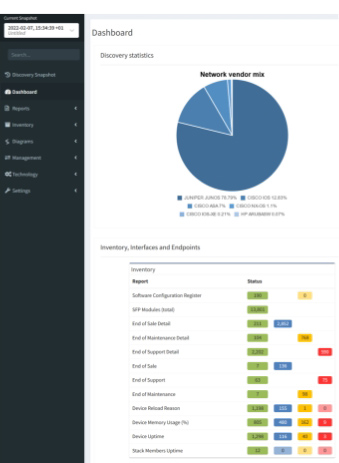

There is inherent and unavoidable complexity in modern enterprise networks. With the demands of more distributed workplaces, remote services, and the necessary diversity of network vendors and technologies, this complexity isn’t going away. Complexity is not only defined by the number of network elements in your environment but the interconnections and relationships between these often differently managed domains. A siloed understanding of your responsibilities or domain without at least visibility of the whole network is simply not sufficient for 2023 networking.
Network professionals must find a way to effectively manage complexity while delivering more than they ever have before – and be careful about their methods. Tools or strategies that paper over this complexity without aiding the operator's understanding of it simply push the problem down the road. When an issue arises that requires wading into the thick of a domain you don’t understand, you’ll be lost in your own network – not ideal.

The answer to this may feel simple – let’s just automate more of our network processes, then we don’t have to deal with this complexity day in and day out - job done, eh? Of course, network automation frees up time by streamlining repetitive and routine operations (software upgrades, device configuration), making your teams more agile, efficient, and in control.
So, what’s the risk? When can it all fold in, and how can you avoid this? Automating:
(1) without a full and accurate understanding of what’s in your network and how it's connected and (2) without a method of validating your network state pre- and post-automated change make it a matter of time before knowledge gaps become a problem for your team.
Automating network processes is heralded as a solution to this complexity but runs the aforementioned risk of becoming a paper tiger; a promised attack plan that crumbles in practice. After all, the difficult part is not pushing config to hundreds of devices. The difficult, but vitally important part, is understanding the full effect of this change on your network as a whole. A holistic view of the effect of change on the network end-to-end is essential.
However, if you choose to bring this understanding to the surface – through homegrown tools, or purchasing a solution – it should be seen as a prerequisite for automation, not a nice-to-have afterthought. This is not a lesson you want to learn the hard way.
If you’re an individual pushing the automation agenda within an enterprise network team, not having the buy-in of leadership can leave your automation projects neglected, and you without the bandwidth to maintain them, properly document their usefulness, and integrate them fully into team-wide workflows.
If the automation push is coming from the organizational level, it may face challenges in terms of coordination and alignment with the overall network operations and business objectives. Lack of clear leadership support and strategic direction can result in fragmented or disjointed automation efforts, where different teams or departments implement automation in isolation, leading to inconsistent results and increased complexity.
Without a unified approach, automation projects may lack the necessary resources, prioritization, and governance to succeed in the long run, leaving them as isolated point solutions rather than part of a cohesive automation strategy. Avoiding these risks requires a collaborative effort between automation advocates and leadership to ensure that automation initiatives are well-planned, aligned with business goals, and supported by the necessary resources and governance to drive meaningful outcomes for the entire organization.
A successful strategy for automating network complexity requires a holistic approach. It starts with gaining a deep understanding of your network environment, including all the network elements, their interconnections, and relationships. Network data is absolutely key to successful automation. A reliable, comprehensive, and up-to-date inventory of your network assets is not just nice to have, but the foundation for effective automation.
Only once this is in place can you start to implement your vision, but here, again, one must be strategic. Starting small is wise, and try to identify low-risk, big-win projects that help prove the value of automation. Finally, ensure that you have robust methods of validating network state before and after automated changes. This includes comprehensive testing, monitoring, and verification mechanisms to catch any discrepancies and ensure network stability.
In general, combining the wins from automation with guarantees of continuous network connectivity and security can help gain the confidence of even the most risk-averse leaders.
Automated network assurance is a trusted way to ensure this necessary confidence as you automate, providing a clear starting point that may take months or years to get to manually. It puts network data in the hands of your team so they can:
(1) proactively detect and resolve issues,
(2) assess the impact of changes and
(3) ensure adherence to stated network intent, which reflects business goals.
It ensures that your network remains stable, secure, and reliable, even as automation efforts accelerate.
So, while automation is often hailed as a solution to network complexity, it requires a thoughtful and strategic approach to be truly effective. Simply automating without a comprehensive understanding of the network and proper validation mechanisms can lead to incomplete or failed automation projects, which means wasted time, potential vulnerabilities, and even more unknowns.

However, by adopting a holistic approach that includes flexible and detailed network mapping, well-defined automation plans, and robust network assurance practices, you can leverage automation as a powerful tool to streamline network operations, enhance agility, and optimize network performance in the face of increasing complexity.

There is inherent and unavoidable complexity in modern enterprise networks. With the demands of more distributed workplaces, remote services, and the necessary diversity of network vendors and technologies, this complexity isn’t going away. Complexity is not only defined by the number of network elements in your environment but the interconnections and relationships between these often differently managed domains. A siloed understanding of your responsibilities or domain without at least visibility of the whole network is simply not sufficient for 2023 networking.
Network professionals must find a way to effectively manage complexity while delivering more than they ever have before – and be careful about their methods. Tools or strategies that paper over this complexity without aiding the operator's understanding of it simply push the problem down the road. When an issue arises that requires wading into the thick of a domain you don’t understand, you’ll be lost in your own network – not ideal.

The answer to this may feel simple – let’s just automate more of our network processes, then we don’t have to deal with this complexity day in and day out - job done, eh? Of course, network automation frees up time by streamlining repetitive and routine operations (software upgrades, device configuration), making your teams more agile, efficient, and in control.
So, what’s the risk? When can it all fold in, and how can you avoid this? Automating:
(1) without a full and accurate understanding of what’s in your network and how it's connected and (2) without a method of validating your network state pre- and post-automated change make it a matter of time before knowledge gaps become a problem for your team.
Automating network processes is heralded as a solution to this complexity but runs the aforementioned risk of becoming a paper tiger; a promised attack plan that crumbles in practice. After all, the difficult part is not pushing config to hundreds of devices. The difficult, but vitally important part, is understanding the full effect of this change on your network as a whole. A holistic view of the effect of change on the network end-to-end is essential.
However, if you choose to bring this understanding to the surface – through homegrown tools, or purchasing a solution – it should be seen as a prerequisite for automation, not a nice-to-have afterthought. This is not a lesson you want to learn the hard way.
If you’re an individual pushing the automation agenda within an enterprise network team, not having the buy-in of leadership can leave your automation projects neglected, and you without the bandwidth to maintain them, properly document their usefulness, and integrate them fully into team-wide workflows.
If the automation push is coming from the organizational level, it may face challenges in terms of coordination and alignment with the overall network operations and business objectives. Lack of clear leadership support and strategic direction can result in fragmented or disjointed automation efforts, where different teams or departments implement automation in isolation, leading to inconsistent results and increased complexity.
Without a unified approach, automation projects may lack the necessary resources, prioritization, and governance to succeed in the long run, leaving them as isolated point solutions rather than part of a cohesive automation strategy. Avoiding these risks requires a collaborative effort between automation advocates and leadership to ensure that automation initiatives are well-planned, aligned with business goals, and supported by the necessary resources and governance to drive meaningful outcomes for the entire organization.
A successful strategy for automating network complexity requires a holistic approach. It starts with gaining a deep understanding of your network environment, including all the network elements, their interconnections, and relationships. Network data is absolutely key to successful automation. A reliable, comprehensive, and up-to-date inventory of your network assets is not just nice to have, but the foundation for effective automation.
Only once this is in place can you start to implement your vision, but here, again, one must be strategic. Starting small is wise, and try to identify low-risk, big-win projects that help prove the value of automation. Finally, ensure that you have robust methods of validating network state before and after automated changes. This includes comprehensive testing, monitoring, and verification mechanisms to catch any discrepancies and ensure network stability.
In general, combining the wins from automation with guarantees of continuous network connectivity and security can help gain the confidence of even the most risk-averse leaders.
Automated network assurance is a trusted way to ensure this necessary confidence as you automate, providing a clear starting point that may take months or years to get to manually. It puts network data in the hands of your team so they can:
(1) proactively detect and resolve issues,
(2) assess the impact of changes and
(3) ensure adherence to stated network intent, which reflects business goals.
It ensures that your network remains stable, secure, and reliable, even as automation efforts accelerate.
So, while automation is often hailed as a solution to network complexity, it requires a thoughtful and strategic approach to be truly effective. Simply automating without a comprehensive understanding of the network and proper validation mechanisms can lead to incomplete or failed automation projects, which means wasted time, potential vulnerabilities, and even more unknowns.

However, by adopting a holistic approach that includes flexible and detailed network mapping, well-defined automation plans, and robust network assurance practices, you can leverage automation as a powerful tool to streamline network operations, enhance agility, and optimize network performance in the face of increasing complexity.





